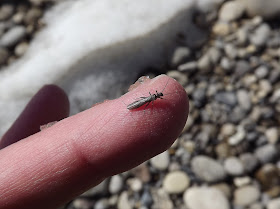Blue Winged Olive mayflies are one of the most common mayflies found in many rivers and streams in Alberta. The term Blue Winged Olive (abbreviated as BWO) is often applied to any small olive mayfly with dusky gray wings and can include species from several genera within the mayfly family Baetidae (Acentrella, Baetis, Cloeon, Diphetor, Plauditus and Procloeon). In a stricter sense the moniker is intended to specifically cover mayflies in genus Baetis, but since many of the other closely related genera have similar appearances and habits, these groups are usually all lumped together as simply Blue Winged Olives (also known as the Baetis complex).
The Baetis complex can produce some of the most consistent hatches of the season; often drawing fish to the surface in large numbers where they can be seen gently sipping crippled emergers or duns from the drift. BWO hatches are usually the first mayfly hatches to materialize in the spring and often extend late into the fall. The importance of this hatch cannot be overstated, and small BWO patterns should be standard in any fly angler’s repertoire. But while BWO emergers and duns can be significant throughout the fishing season, it is the tiny Baetis nymphs that draw the most attention early in the spring.
As the water starts to slowly warm, aquatic insects that have spent the winter in the nymph phase of their life cycle become much more active – moving from deeper pools and runs to shallower riffles and feeding areas along the banks. On fertile streams like the Bow River, Baetis nymphs form a significant part of the biomass. With so many of these tiny nymphs moving about, and sometimes getting caught in the drift, the fish quickly form a search image. This is a very important point – it means that the fish have learned that any small olive tidbit with the general shape of a Baetis nymph is likely safe to eat. Tie on a Baetis nymph and the odds are stacked in your favor.

Baetis nymphs range from 3 to 10 mm long. Colors can be shades of light to medium olive, olive brown or tan, with mottled medium olive being the most common. There are several commercial patterns that can be used to imitate a Baetis nymph; one of the most popular being the Pheasant Tail Nymph. The Pheasant Tail can be an effective pattern in size 16 or 18 but the color is generally a little dark compared to most Baetis nymphs. I like to use a fly tied in a similar format to the old reliable Hare’s Ear:
Hook: Mustad 3399 (or equivalent), #16-18
Thread: 8/0 medium olive
Tails: 3 mallard flank fibers, olive
Rib: fine silver wire
Abdomen: medium olive dubbing
Wing Case: mottled brown turkey quill
Thorax: medium olive rabbit dubbing (a few hairs picked out as legs)
I also tie two other color variations where I mix in a little tan or amber dubbing with the medium olive to get a slightly mottled appearance.

.jpg)
.jpg)
.jpg)
.jpg)
.jpg)
.jpg)



.jpg)


.jpg)